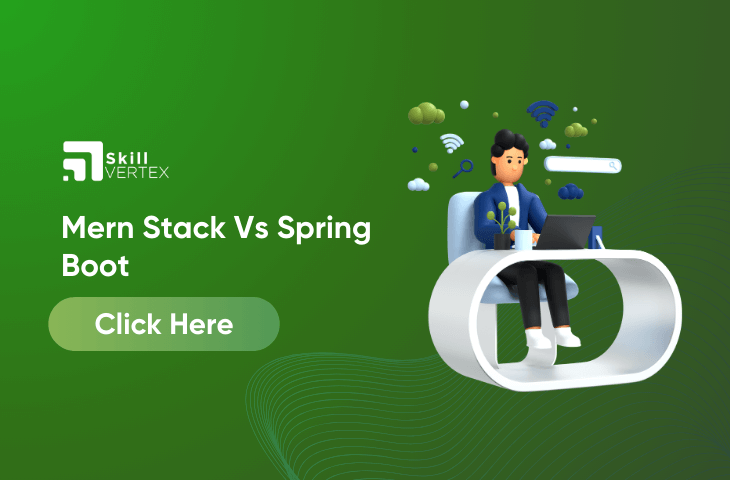Table of Contents
Mern Stack Vs Spring Boot
In the ever-evolving landscape of web development, the choice of a technology stack plays a pivotal role in shaping the trajectory of a project. Two prominent options, the MERN stack (MongoDB, Express.js, React, Node.js) and Spring Boot, have emerged as robust solutions, each offering unique strengths to developers. The MERN stack, celebrated for its JavaScript-based components, provides an end-to-end environment for full-stack development, excelling in the creation of modern and interactive web applications. On the other hand, Spring Boot, powered by the Java programming language, offers a comprehensive framework with a focus on simplicity and convention over configuration. In this comparison, we will delve into the distinctive features of the MERN stack and Spring Boot, exploring their advantages, use cases, and considerations to aid developers in making informed decisions based on project requirements and preferences.
Understanding Mern Stack
The MERN stack is like a team of tech tools that work well together to build cool websites. Imagine MongoDB as the organized storage, Express.js as the helpful framework, React as the creative front-end maker, and Node.js as the engine that runs everything. MongoDB is good at handling different kinds of data, Express.js makes building server-side stuff easy, React creates dynamic and responsive website parts, and Node.js keeps everything running smoothly. Together, they make it simple and fun to create modern web applications!
Spring Boot
Spring Boot is like a helpful toolkit in the big Spring family that makes it easy to create applications ready for real use. Here are some important parts of Spring Boot:
- Spring Framework: This is a big set of tools for building Java applications. It covers a lot, from how different parts of the app talk to each other to handling special tasks in programming.
- Spring Boot Starters: Think of these like ready-made blueprints that make setting up parts of your application quicker. They help with things like databases, security, and messaging.
- Embedded Servers: Spring Boot comes with servers built-in, like Tomcat and Jetty. This makes it easier to test and put your app into action.
- Spring Boot Actuator: This is like a set of tools for making sure your app works well when it’s out there being used. It helps keep an eye on how healthy your app is and gathers useful data about it.
Benefits Of Mern Stack
Full JavaScript Stack:
If your team is already familiar with JavaScript, using the MERN stack ensures a smooth development process by maintaining consistency in language across the entire stack.
React for Rich UI:
Utilizing React in the MERN stack allows for the creation of highly interactive and dynamic user interfaces, thanks to its efficient component-based approach.
Scalability:
MongoDB’s NoSQL nature supports horizontal scalability, making it a suitable choice for applications anticipating high traffic and rapid growth.
Real-time Applications:
The event-driven architecture of Node.js, a key component in the MERN stack, is well-suited for real-time applications such as chat or collaboration tools.
Benefits Of Spring Boot
Java Ecosystem:
If your team excels in Java, opting for Spring Boot can ensure a smoother and more productive development process.
Robust Framework:
Spring Boot’s extensive ecosystem covers nearly every aspect of application development, providing robust solutions for security, data access, and more.
Enterprise Ready:
Known for its maturity and proven track record, Spring Boot is a preferred choice for constructing large-scale and enterprise-grade applications.
Microservices:
Spring Boot’s modular architecture is well-suited for developing microservices-based applications, promoting scalability and maintainability.
Considerations for Decision-Making:
- Skill Set:
Evaluate your team’s proficiency in JavaScript and Java. Aligning with your team’s strengths can lead to faster development and reduced learning curves. - Project Complexity:
For relatively simpler applications, MERN’s simplicity might suffice. However, for complex enterprise applications, Spring Boot’s comprehensive features could be more suitable. - Scalability and Performance:
Consider the scalability requirements of your application. While both stacks can scale, MongoDB’s NoSQL structure might be more advantageous for high-traffic scenarios. - Community and Support:
Both stacks boast vibrant communities and extensive documentation, but Spring Boot’s longer presence in the industry might offer more mature solutions.
FAQ- Mern Stack Vs Spring Boot
Q1. Is Spring Boot in demand 2023?
Ans. Mastering Spring and Spring Boot remains highly valuable in the software development field. Widely adopted in the industry, these frameworks offer versatility, particularly in building scalable enterprise applications and adapting to microservices architecture. The active community support, ongoing demand in the job market, and the frameworks’ ease of development contribute to their continued relevance. While staying updated on emerging technologies is essential, investing in Spring and Spring Boot skills proves beneficial for developers.
Q2. Is Spring Boot high paying?
Ans. A Java Spring Boot Developer can earn up to ₹9.4 Lakhs per year, equivalent to ₹78.3k per month, as of the available information. Actual salaries may vary based on factors like experience, location, and industry demand.
Q3. Is Spring Boot easy or tough?
Ans. Spring Boot simplifies the development and testing of applications with its built-in command-line interface (CLI). In comparison to Spring, which involves more source code and makes testing challenging, Spring Boot streamlines the testing process by eliminating the need for boilerplate code. This makes testing in Spring Boot more straightforward and less cumbersome.
Hello, I’m Hridhya Manoj. I’m passionate about technology and its ever-evolving landscape. With a deep love for writing and a curious mind, I enjoy translating complex concepts into understandable, engaging content. Let’s explore the world of tech together

